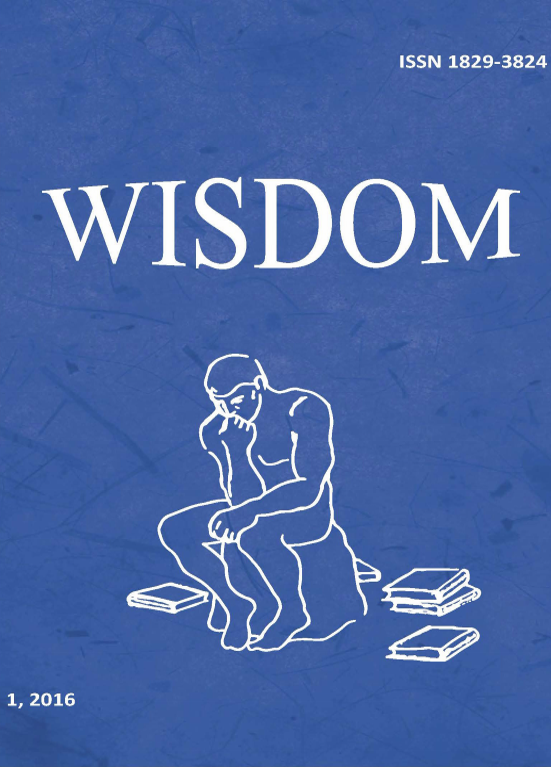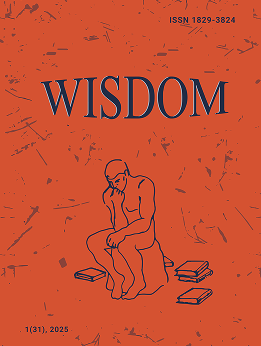The Chief and His Sacral Power
DOI:
https://doi.org/10.24234/wisdom.v6i1.64Keywords:
the authority, the archaic society, the chief, the chiefdom, the sacral powerAbstract
The emergence of the chiefdom is associated with a qualitative change in the nature of political power. Unlike the bigman, who was constantly forced to prove the right on the authority by his actions, the chief uses to strengthen his authority a new, unprecedented means. He becomes the mediator between the community members and the deities, and largely because of this he increasingly distances himself from the bulk of the congregation. Often the chief transferred his functions to assistants, that to deduce himself from the blow of criticism for mistakes and miscalculations of his policy, taking the role of the sacral authority owner. The chief’s authority has strengthened even more due to the fact that the chief often have arrogated to oneself the right to carry out religious rites.
Occupying a central place in the political, social and cultural life of the archaic society, representing the stability and the prosperity, the chiefs became a sort of pivot point for the whole structure of the worldview of the ancient human. As such, the chief appropriated additional symbolic resource which he used to further consolidate his power. He surrounded himself with professional assistants and soldiers, he strengthened institutions for the transfer of power. Thus, the sacralization of the chief’s power becomes an important condition of the society’s transformation from chiefdom to more complex form of social organization – to the early state.
Downloads
References
Claessen, H.Y.M. (1978). The Early State: A Structural Approach // H.Y.M. Claessen, P. Skalnik (eds.) The Early State. The Haague; Paris; N.Y.
de Cogolludo, L. (1954). Historia de Yucatan. T. 1. Campeche.
de Villagutierre Soto-Mayor, J. (1933). Historia de la conquista de la provincial de el Itza. Guatemala.
De Landa, D. (1955). Soobshheniya o delakh v Yukatane (Reports about Affairs in the Yucatan). Moskva, Leningrad.
Eliade, M. (1995). Aspekty mifa (Aspects of the myth). Moskva.
Eski dzhyrla (1993). Starinnye pesni (Old Songs). Mingi-Tau. ? 4(50).
Frezer, Dzh. (2001). Zolotaja vetv': Issledovanie magii i religii (The Golden Bough: A Study of Magic and Religion). V 2 t. Per. s angl. M. Ryklina. M.: TERRA-Knizhnyj klub.
Gerodot (1972). Istoriya v devyati knigah (History in Nine Books). Per. i prim. G.I. Strata-novskogo. Kn. IV. Leningrad.
Gil'ferding A.F. (1855). Istoriya baltiiskikh slavyan (History of the Baltic Slavs). T. 1. Moskva.
Guljaev, V.I. (1990). Gosudarstvennaya ideologiya drevnikh maiya (k voprosu o kul'te carskikh predkov) (State Ideology of the Ancient Maya (on the question of the cult of the king's ancestors)). Problemy arkheologii i drevnei istorii stran Latinskoi Ameriki. Moskva.
Gurevich, A.Ya. (2005). Dialektika sud'by u germancev i drevnikh skandinavov (The Dialectic of the Germans and the Fate of the Ancient Scandinavians). Mifologema zhenshhiny-sud'by u drevnikh kel'tov i germancev / Otv. red. T.A. Mihailova. Moskva.
Khazanov, A.M., Chernenko, E.V. (1979). Chas i motivi pograbuvannya skifs'kikh kurganiv (Time and Motives of Robbery of Scythian Burial Mounds). Arkheologiya. Kiïv. ? 30.
Kradin, N.N. (1995). Vozhdestvo: sovremennoe sostoyanie i problemy izucheniya (Chiefdom: Current Status and Problems of Study). Rannie formy politicheskoi organizacii: ot pervobytnosti k gosudarstvennosti. Otv. red. V.A. Popov. Moskva.
Kradin, N.N. (2001). Politicheskaya antropologiya (Political Anthropology). Ucheb. posobie. Moskva.
Materialy po istorii syunnu (po kitaiskim istochnikam) (Materials on the history of the Huns (by Chinese sources)) (1968). Per. i prim. V.S. Taskina. Vyp. 1. Moskva.
Nilsson, M. (1933). Homer and Mycenae. London.
Od., XIX.
Pavel Diakon. Istorija langobardov (History of the Lombards). Svod 2.
Potapov, L.P. (1991). Altaiskii shamanism (Altai Shamanism). Leningrad.
Prokopii Kessariiskii. Istoriya voin (The History of Wars). Svod 1.
Puzanov, V.V. (2007). Drevnerusskaya gosudarstvennost': genezis, etnokul'turnaya sreda, ideologicheskie konstrukty ((Old Russian Statehood: the Genesis, Ethno-cultural Environment, Ideological Constructs). Izhevsk.
Puzanov, V.V. (1997). U istokov vostochnoslavyanskoi gosudarstvennosti (At the Root of the East Slavic Statehood). Istoriya Rossii: Narod i vlast'. Sankt-Peterburg.
Romanov, V.N. (1991). Istoricheskoe razvitie kul'tury (The Historical Development of Culture. Typology of Problems). Problemy tipologii. Moskva.
Savinov, D.G. (1997). Pogrebal'nye kamery-«chasovni» Bol'shikh Pazyrykskikh kurganov (Funeral Box-"Chapels" of the Great Pazyryk Mounds). Sakral'noe v istorii kul'tury. Sankt-Peterburg.
Sidahome, Y.E. (1964). Stories of the Benin Empire. London; Ibadan.
The Kumulipo (He Kumulipo no ka I-i-mamao a i Alapai-wahine). (1951). / Ed. By Beckwith M.W. Chicago: Chicago University Press.
Thompson, J.E.S. (1954). The Rise and Fall of Maya Civilization. Norman: University of Oklahoma Press.
Tolochko, A.P. (1992). Knyaz' v Drevnei Rusi: vlast', sobstvennost', ideologiya (The Prince in Ancient Russia: Power, Property, Ideology). Kiev.
Tolochko, O.P. (1994). Rus': derzhava i obraz derzhavi (Ancient Russia: Power and the Image of Power). Kiïv.
Tumans, H. (2002). Rozhdenie Afiny. Afinskii put' k demokratii: ot Gomera do Perikla (Birth of Athena. Athens Way to Democracy: from Homer to Pericles). Sankt-Peterburg.
Vasil'kov, Ya.V. (1979). Zemledel'cheskii mif v
drevneindiiskom epose (Skazanie o Rish'yashringe) (Agricultural myth in ancient Indian epos (The Legend of Rishyashring)). Literatura i kul'tura drevnei i srednevekovoi Indii. Moskva.
Downloads
Published
How to Cite
Issue
Section
License
Creative Commons Attribution-Non-Commercial (CC BY-NC). CC BY-NC allows users to copy and distribute the article, provided this is not done for commercial purposes. The users may adapt – remix, transform, and build upon the material giving appropriate credit, and providing a link to the license. The full details of the license are available at https://creativecommons.org/licenses/by-nc/4.0/.















